2015 marked the 100th anniversary of the birth of one of Britain’s most important post-war graphic designers, Hans Unger (1915-75). A prolific poster artist (he produced 117 designs for London Transport alone), Unger was also an accomplished mosaicist and illustrator. In this blog, author and designer Naomi Games (daughter of Abram Games) recalls Hans’ unique contribution to British design.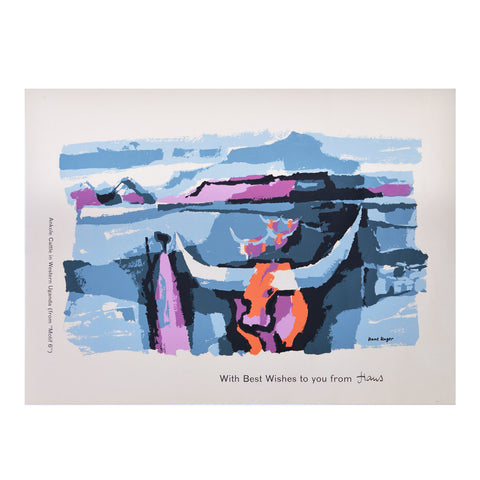 Hand signed greetings lithograph, 1961
Hand signed greetings lithograph, 1961
Hans Unger was a very close friend of our family. ‘Uncle’ Hans would arrive at our house by bicycle with a huge smile, a good sense of humour and with a lighted cigarette always attached to his elegant hand. He had no children, so he borrowed the Games children and took us on adventures in his sports car. My parents had no car, but they did have a large colourful Unger mosaic taking pride of place on the living room wall. We could never work out what the image was of, but we liked it and still cherish it.
Born to Jewish parents in Prenzlau, Germany in 1915, in 1934-35 Hans studied poster design with Jupp Wiertz in Berlin. Sensing danger looming, he left for South Africa in 1936 and joined the army. Stationed in East Africa, Egypt and Libya, while in Tobruk in 1942, Hans was taken prisoner by the Germans. After a year in a prisoner of war camp in Italy, he made a heroic escape walking through France and crossing the Pyrenees into Spain in deep winter. Unfortunately, he suffered frostbite and lost some toes.
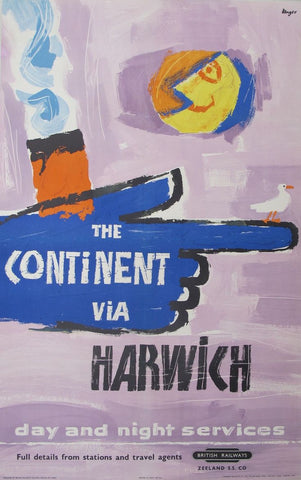
Poster design for British Railways, 1950s
Hans returned to South Africa the following year but arrived back in London in 1948 resuming work as a designer and became a naturalized British subject. He designed many posters for London Transport, British Rail, the Observer and the General Post Office.
Colour was an important aspect of his work. A great traveller, he visited Uganda in 1958 and, a year later, he cycled through Europe to Turkey and Persia. His poster work earned him an international reputation.
Ideal Home Exhibition poster, 1958
Since the late 1950s new American style advertising agencies with their photographic posters were making the handcrafted poster a rarity. Around this time, he developed an interest in stained glass windows and mosaics, employing these techniques in his poster work. Hans designed five tiled murals for the new Victoria line including those at Oxford Circus and Green Park underground stations. He illustrated several book covers and three for the ‘Abram Games Penguin colour experimental series’ in 1956 -7.

Cover design for Margery Allingham's Death of a Ghost, Penguin, 1956/57
In partnership with Eberhard Schulze, Unger created many mosaic murals and stained glass windows for several churches from a small terraced house in Highgate. Early works were interpretations of Hans’s graphic work, but as he gained confidence, the work became more abstract and simpler. Abram Games said “His mosaic work is quite outstanding – he built on new architectural techniques in an extremely original style.”
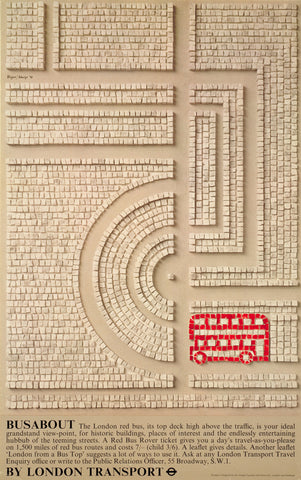
Busabout, London Transport poster (with Edward Schulze), 1970
In 1964 the Unger Mosaic workshop designed a large mosaic for the entrance hall of Penguin’s staff canteen in Harmondsworth, West Drayton. It has now been moved to Rugby. Including fragments of metal type, whole linotype pages and all the symbols in the Penguin aviary, it was ambitiously made from a combination of Italian glass ‘smalti’ mosaic tesserae, Welsh slate, slabs of stone and majolica tiles inlaid in cement.
In 1965, Unger wrote Practical Mosaics, published by Studio Vista. He made a moving dedication to Eberhard Schulze; “in memory of all the mosaics we scrapped while learning our craft.” Sadly, their partnership ended after creating a large mural for the new Royal Free Hospital in Hampstead, London. To Hans’s horror, the mural had to be trimmed to fit.
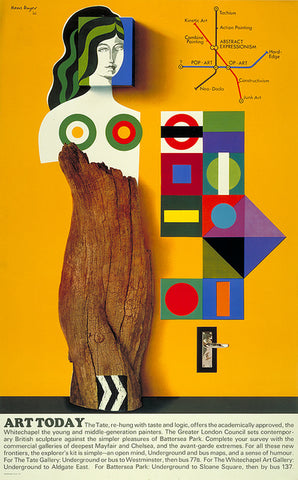
Art Today, London Transport poster, 1966
Hans’s death in June 1975 at the age of 59 came as a huge shock. I was 24 and had become a designer myself. I loved Hans and admired his work so I suggested to my father, Abram, that an exhibition should be organized. He agreed and we proceeded to track down his work, which was uncatalogued and dispersed over many continents. Many friends helped and two years later, we held a commemorative exhibition in London for our dear Hans. Abram arranged for his archive to be given to the Victoria and Albert Museum’s Archive of Art and Design, and some of his work can now also be found in the archives of the Post Office and at the London Transport Museum.
A private man, Unger was often critical of his own work, he was unsentimental and outspoken but was always admired. After his death, Abram wrote in the Designer, ‘Hans’s individual techniques and colour sense were entirely new to the poster and his designs were eagerly sought by museums and collectors all over the world. Because he gave so much, his design will continue to grow in importance as ever increasingly the eye of the designer gives place to the camera.'

Keep Britain Tidy poster, 1955
To this day, although he earned an international reputation as a designer and master of mosaics, I believe Hans Unger has never received the attention and accolades he rightly deserves.”
A selection of original Hans Unger posters and prints currently for sale can be viewed here.

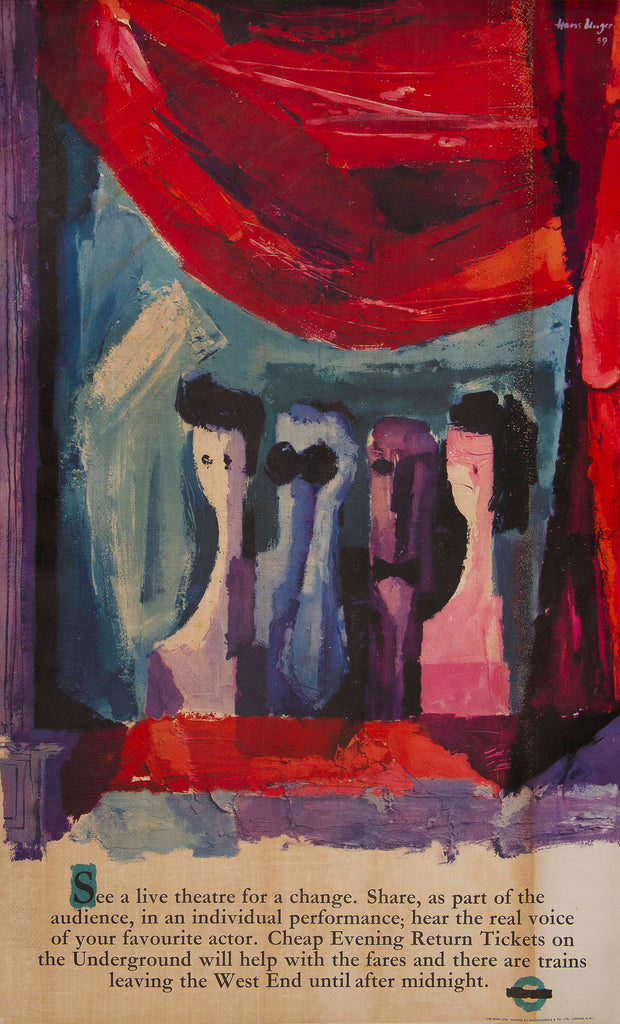


Comments on post (6)
Dr ILONA JESNICK says:
There is an article on the Unger-Schulze studio in volume 6, 2012, of the journal ANDAMENTO, ISSN 1752-5578, pp.14-23. It contains an image of the Penguin mosaic in full colour, with several enlarged details. Many other pictures of mosaics and Unger’s posters.
Alex McHallam says:
This is a long shot but worth a try! Does anyone know if Unger & Shultz made a mosaic for St Michael’s Catholic Grammar School in Finchley? The school owns a striking mosaic which dates from 1957. Unfortunately it is under threat as the site is going to be developed. I’ve been asked to help find who the artist is to help with the case to preserve it. I can send an image of it to anyone who wants to see it. The date and location and indeed the style fits with it being an Unger. I am a mosaic artist and a member of British Association for Modern Mosaic. I have a particular interest in the history of Modern Mosaics to ensure they are saved. Thanks
Andrew Brown says:
Great article. I visited Hans’ studio at the top of Cranley Gardens at least a couple of times in the late 1960s when Chris Nagorski and Richard Thompson we’re working as assistants. I would be interested in buying a print of the Ankole Cattle lithograph if available anywhere. Any tips on where to find this (or other originals by Hans) would be appreciated.
Stephen Schulze says:
Great article! I’m the son of Eberhard Schulze and of course have many of their original mosaics and many untold memories
Sally Moyes says:
I wish I had been in touch earlier. I have three of Hans’s mosaics that he made for us as we knew him quite well in London and he visited us in Oxford. He made a stained glass window for our London house which sadly we had to leave behind when we moved. I wonder if it is still there. I have so many memories of Hans I would love to share.
Graham Twemlow says:
Fascinating piece Naomi. I’d love to see a photo of the Penguin canteen mosaic.
Leave a comment